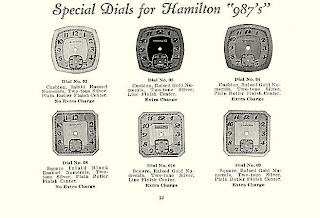 |
| Undocumented Hamilton |
 That’s a good question. People have spent untold time and energy trying to find the answer. It’s not intuitive, because the watch on the right is not a Hamilton in the first place. It is an Illinois wristwatch. You might ask, “but what about the dial? It resembles a Prescott.” – It really does have that look. It also resembles
That’s a good question. People have spent untold time and energy trying to find the answer. It’s not intuitive, because the watch on the right is not a Hamilton in the first place. It is an Illinois wristwatch. You might ask, “but what about the dial? It resembles a Prescott.” – It really does have that look. It also resembles
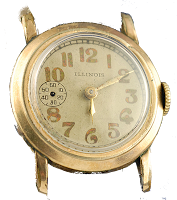 |
| Illinois |
Hamilton’s Moese pocket watch made in 1937. People refer to the style as having “Bartley Markers”. On close examination, you will see that they all differ somewhat from the Prescott and other Hamiltons with this style of marker. For example, the Prescott has a larger circle around the middle of the dial; the second hand is in the six O’Clock position and the cases don’t match. The undocumented Hamilton to the right has painted hour markers while Hamilton gave the Prescott and Moese raised gold ones. Did I hear someone say the watch has a Hamilton logo? It does indeed, but we need to dig deeper to uncover the mysteries surrounding this watch.
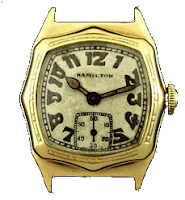 |
| Hamilton Pinehurst |
For the first 40 years of its existence, the company that inevitably became Hamilton was a railroad watch manufacturer. Many people mark 1892 as the birth of Hamilton, but the original Lancaster company began in 1873. Some incarnations and reorganizations later, a group of businessmen recapitalized the ailing Lancaster, Pennsylvania watch company. To shore up the company’s production, they bought the assets of a bankrupt watch company in Illinois and mandated the goal of only building quality watches. As their reputation for quality grew, affluent individuals began asking for those highly accurate watches used by railroads. Under pressure from the market, Hamilton moved into the consumer business. Here’s how a railroad watch company enters the consumer market.
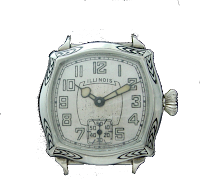 |
| Illinois Jolly Roger |
When a customer wanted to buy a Hamilton pocket watch, they would go to a jeweler, pick a dial from a large selection, choose a case and the movement. The jeweler would put them together, sleeve the winding mechanism and that was the business process for selling watches.
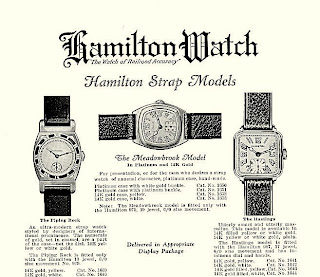 Hamilton carried that business process into the era of wristwatches. Notice the two photocopies from their 1929 catalog below. Hamilton stuck to its pocket watch model of doing business. Three cases, one movement, pick out your dial and you had your watch. Hamilton shipped the movements separately, the dials and cases came from another division.
Hamilton carried that business process into the era of wristwatches. Notice the two photocopies from their 1929 catalog below. Hamilton stuck to its pocket watch model of doing business. Three cases, one movement, pick out your dial and you had your watch. Hamilton shipped the movements separately, the dials and cases came from another division.
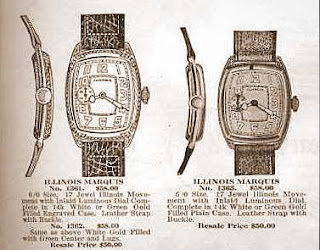 |
| Illinois add showing the nine O’clock second hand |
Hamilton only had one slight problem selling their wristwatches – their competition used a different business approach and Hamilton lacked the processes to match. Elgin, for example, shipped their wristwatches already cased and dialed. The jeweler had less work to do and made a higher profit.
Fortunately for Hamilton and people who wanted a great wristwatch, the Illinois Watch Company went up for sale. Now, Illinois made great railroad watches and had a high-end wristwatch business with a modern selling process to match.
In 1927, the death of Jacob Bunn, Jr. threw Illinois Watch into disarray. In 1928, Hamilton bought the Illinois Watch Company for $5 million. Hamilton continued to operate the factory under the Illinois name and shifted the emphasis from pocket to wrist watch production. By 1932, the Great Depression forced Hamilton to close the Illinois factory, though they retained possession of the brand name.
The following information explains how the Illinois Watch Company evolved their wristwatch business and morphed themselves into Hamilton. The result of which created the premiere wristwatch company in the world.
Illinois Watch Company had four basic “periods” of wrist watch production. The first period was from the 1910s to the early 1920s, during which most wristwatches were converted pocket watch movements. Gent’s military and military-style specimens were made, often featuring porcelain dials.
The second period—from the early to mid-1920s—included movements and dials which were sold to be cased by individual jewelers. These were mostly small 6/0-size movements with 6:00 or 9:00 subsidiary seconds. Some were also cased at the factory using generic cases from a variety of sources. Some of the better-known models from that latter category include the Square, Canby, Square Cut Corner, Cushion, and Whippet. Also, larger 3/0-size movements were cased at the factory in this way—the Champion, Special, Ace/Maxine, and Atlantic, for example.
In the late 1920s, shortly before the Hamilton Watch Company took over, Illinois began commissioning its own unique wrist watch cases. The company cased and boxed its watches at the factory, marking the beginning of what many collectors consider the company’s golden era, during which the finest watches were made. Models include the Picadilly, Major, Marquis, Chieftain, Ritz, New Yorker and Manhattan (the New Yorker came with a leather strap, the Manhattan with a metal one), the Beau series
| Beau Brummel |
(Beau Monde, Beau Geste, Beau Brummel, and Beau Royale), the Mate, and the top of the line 14-karat solid gold Consul. Many collectors consider The Consul to be the finest American wrist watch ever made—examples with original silver pinstripe dials, starburst dials, and with a small second hand are especially desired. Some of these art deco models also came in 2-tone gold (white gold sections along with yellow or green gold) which are also very desired and rare.
The fourth period began in the early 1930s, and is characterized by the Streamline Moderne influence on the styling of the cases. Many of these watches featured a new 207 movement, 12/0-size with 17 jewels (of which only 40,000 were made) and included such sleek designs as the Futura, Chesterfield, Wentworth, Andover, and the 14kt Rockliffe. Many of these are very similar to watches made at the time by the Hamilton Watch Company. (The four paragraphs above came from Wikipedia).
Let’s see. What was the question?
What model and date are those Hamiltons with the second hand at 9 O’Clock?
The date is 1928. Hamilton made a movement in 1923-24 that would have had a second hand in the 9 O’Clock position. That was the 986, which was a size 6/0 caliber pocket watch movement for women. When you turn a pocket watch movement so that the hour and minute hand sit like a wristwatch, then the minute hand becomes set in the 9 O’Clock position. Hamilton didn’t make the 986 movement in 1928. They did make 6/0 wristwatch movements like the 987. The 987 was not a pocket watch movement.
Ask yourself if the Hamilton wristwatch at the top of this page looks like models Hamilton made in the late 1920’s or early 1930’s – the ones in the advertisement above. Well, of course not. They do resemble cases designed by Illinois and made by Fahy and Wadsworth.
At the cost of sounding redundant, is that watch a Hamilton or an Illinois? You could only tell by looking at the movement. I don’t know of any Hamilton movements that would fit the configuration of the round watch above. Let’s just say it’s undocumented.
When you look at Hamilton wristwatches that began to look sophisticated instead of like some curved and engraved pocket watch, then you’ll realize from where the influence came: Illinois.
Finally, let’s remember one thing about producing wristwatches 88 years ago: A jeweler could put a movement in any case he wanted. Also, when a dial refinisher is asked, he or she can put the Hamilton logo on any dial. I hope this has opened someone’s eye. It did mine.
“Hamilton closed the Illinois Watch Company factory in 1932, maintained the brand name, shifted the emphasis from pocket to wristwatches and launched their own wristwatch division.”
Copyright 2006-2017 | All Rights Reserved

